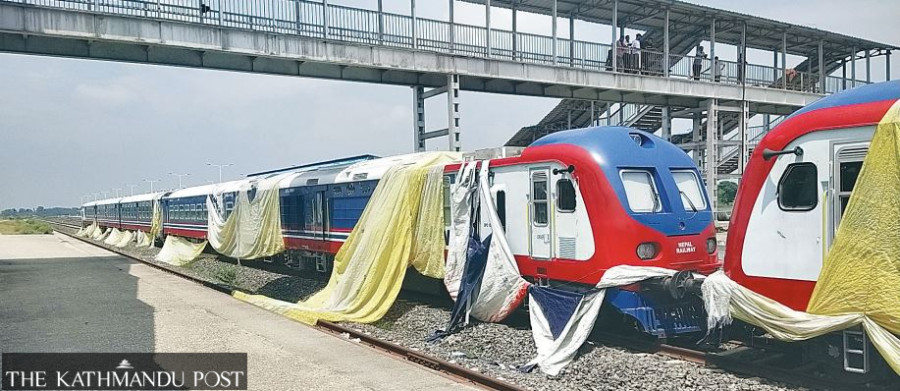National
A new train last year was welcomed with much fanfare. It never ran
Political, legal and technical issues have prevented the brand new locomotives that Nepal bought from India from coming into operation—on a new track.
Sangam Prasain, Prithvi Man Shrestha & Shuvam Dhungana
Exactly a year ago, on September 18, when two brand new train sets arrived at Janakpur station, Kedar Thakur of Bhanu Chowk, was thrilled.
Thakur, along with hundreds of other people, could not resist the temptation of going to see the new machines of which they had been hearing for quite a while.
These were the country’s first broad-gauge trains, a new avatar of the historic Janakpur-Jaynagar railway between Nepal and India which was once a major means of border crossing for citizens from both sides. First built as a cargo line to carry timber from Nepal to India in 1937, the 35km railway from Janakpur in Nepal to Jaynagar in Bihar, India was a lifeline for people in Janakpur.
“Everyone was excited. We didn’t even care about the coronavirus lockdown. We just wanted to see the train,” Thakur, 51, told the Post.
“It was Friday [September 18],” Thakur remembers. “I, along with some of my friends, had gone to the station. There was a huge crowd, all people eagerly waiting for the train to arrive.”
People who had seen the colonial era train chugging along the Nepal-India narrow gauge track were excited to see Nepal's first modern train. The train came.
“And since its arrival, it's been there… stationary,” said Thakur. “It was covered with yellow plastic sheets. Now the plastic sheets have been tattered.”
Saturday marks the first anniversary of the arrival of the gleaming new train. And had it started rolling on the new broad-gauge tracks, it would have marked a new era in Nepal’s railway history.
Dubbed Janaki Rail, it has five coaches and can carry 1,000 passengers, sitting and standing, at a time. The train, with a maximum speed of 110 km per hour, was procured at Rs850 million.
Supendra Kumar Kushwaha, another local, said he too was very excited that resumption of the service would bring back the lost glory of Janakpur.
Many had hoped that the railway service would create employment for locals, boost business activities and give a fillip to tourism in Janakpur, the birthplace of goddess Sita, where the Ram Janaki temple is a major religious and tourism attraction.
Kushwaha is one of the applicants for a job at the railway. He is still waiting for the railway authority to conduct the exams.
“Vacancies were announced but the Department of Railways is yet to schedule the exams despite taking fees from the applicants,” Kushwaha told the Post.
A vacancy notice was issued for 129 employees and more than 32,000 people had applied. The Department of Railways had collected up to Rs1,000 per person as exam fees.
“I applied for a job months ago. There is no update on exams,” said Kushwaha. He does not know why the train service has not come into operation even one year after it arrived in Nepal.
In Nepal, railway is one of those many things promised by governments that stir up emotions among people and inspire hope. After KP Sharma Oli came to power in 2018, connecting Nepal with both its immediate neighbours—India and China—by trains was his common refrain. When the train arrived last year, the Oli government boasted it as one of its biggest achievements.
But locals say what is the use of a machine that sits immobile.
Like every other development project that often falls victim to political games, Nepal’s railway dreams were also shattered by political wranglings.
To operate the trains, Nepal needed laws. And there were none.
Three months after the train arrived, Oli on December 20 last year dissolved the House, after protracted internal disputes in the then ruling Nepal Communist Party (NCP), and declared polls. Amid political uncertainty, railway service was not the government’s priority. On February 23, the Supreme Court restored the House of Representatives, but political bickering continued. Oli continued to threaten to dissolve the House again as he went for a floor test, lost it, got appointed again and created more confusion by asking the President to invoke Article 76 (5), a move that constitutional experts were quick to call unconstitutional.
On May 5, the government introduced an ordinance on railway operations. But on May 21, Oli dissolved the House for a second time, throwing the country into uncertainty again. About two months later, on July 12, the Supreme Court not only restored the House but also threw Oli out of office and ordered the appointment of Sher Bahadur Deuba as new prime minister.
The Deuba government on July 18 presented the ordinance on railway operations before Parliament. The ordinance has now become invalid because it failed to get Parliament’s nod within 60 days since it was tabled. The deadline ended on September 16.
“Laws are a must. Without laws, we cannot operate the trains,” said Niranjan Jha, general manager at Nepal Railway Company Limited. “There is uncertainty now.”
Jha was appointed on August 19 this year.
Even more than two months after his appointment, Deuba has not been able to expand his Cabinet. There is no dedicated minister at the Ministry of Physical Infrastructure and Transport, which oversees the Department of Railways.
“Once we get the minister, we have plans to complete all formalities within a day. We are ready from our side,” said Keshav Kumar Sharma, joint-secretary at the Ministry of Physical Infrastructure and Transport. “As railway is of paramount importance, we have accorded high priority to this project.”
According to him, the Cabinets of both Nepal and India have approved the standard operating procedures for the cross-border railway service. “Our Cabinet has authorised the director general of the Department of Railways to sign the document while India may also assign an official,” he said.
According to him, Nepal’s plan is to sign the standard operating procedure, take over the Kurtha-Jaynagar railway infrastructure from India and operate the railway service at the same time.
“Instead of organising separate events for these tasks, we plan to do them by organising a single event,” said Sharma.
After the railway infrastructure was prepared from Kurtha to Jaynagar last year, two rail coaches were brought. There are two other sectors—Bhangaha in Mahottari and Bangaha to Bardibas, 17 kilometres each.
The plan to bring trains had started soon after Oli was appointed prime minister in 2018.
On May 10, 2019, the Department of Railways signed an agreement with India’s Konkan Railways Corporation Ltd to supply two diesel-electric multiple unit train sets for passenger services from Kurtha in Janakpur to Jaynagar in India.
The two sets of trains arrived in the country on September 18 last year, as per the agreement signed between the two sides.
“The one-year warranty of the rail sets has also expired, and there are concerns about their maintenance,” said Jha.
The Indian company had trained some Nepalis in April for 10 days before the second wave of pandemic hit the country. As per the agreement, Konkan Railway would assign 26 staff members for operating Nepal’s railway.
“They are supposed to work in Nepal for one year afer the railway service starts,” said Sharma.
But there is a lack of local staff, both technical and administrative, to operate the trains.
“Nepal doesn't have staff to operate the train. Everyone knew that,” said Ananta Acharya, former director general at the Department of Railways. “But no one paid attention to this simple fact. Don’t we need to prepare a workforce to operate the trains before their arrival?”
According to him, right after the agreement was signed with the Indian side to purchase the rail sets, staff should have been recruited.
“When we met then Indian ambassador Manjeev Singh Puri in early 2018, he had assured us that the Indian side was ready to provide training for the Nepali staff,” he said.
The Nepal Railway Company had announced vacancies only on September 14 last year, even as authorities knew that the trains would arrive on September 18.
In November last year, the railway company tried to hire staff on a contract basis. But there were no bylaws to do that.
The Public Service Commission, the agency tasked with hiring staff in government bodies, held it back, asking the company to hire staff only by introducing the recruitment bylaws. The bylaws consist of procedures that require the company to form a recruitment committee, which shall have a Public Service Commission representative as member.
"The government can recruit staffers by itself on contract, but a commission representative needs to be involved in the recruitment process. In the case of permanent staffers, the commission does the recruitment," an official of the commission told the Post last year.
Several months after the trains arrived, the railway company did recruit a little over 150 staff members on a daily-wage basis. This was bound to become a political issue. As soon as the new government came, all the staffers were removed, saying they were “politically appointed”.
They were trained by the Indians.
“How is the new government planning to operate the rail service after removing staff who had at least received some training to help operate the railway service?” said Acharya.
The staff recruited on a daily-wage basis were supposed to work in track stations as signal staff.
Jha, however, claimed that the daily-wage workers were dismissed as the company had to spend Rs6 million a month on them without any work.
“I have been discussing with the Public Service Commission for the recruitment of permanent staff,” Jha told the Post.
For the incumbent government, which appears to be completely disoriented, railway does not seem to be a priority though.
The former and incumbent general managers of the Nepal Railway Company gave conflicting statements regarding preparations for operating the trains.
While Jha, the general manager, said that preparation for railway operation is “still at an early stage”, Guru Prasad Bhattarai, former general manager of the company, said that he had invited the then prime minister Oli to inaugurate the railway service on July 9.
“I had to leave the company after the change in government,” he said.
Bhattarai was removed by the Deuba government.
“Now there is uncertainty. There is no law as the ordinance on railway operations has lapsed. And there is this risk of our contract with Konkan getting terminated due to prolonged delay,” said Bhattarai.
Bhattarai said that Konkan may demand cost adjustment if railway service continues to face delays. The two sides had signed an agreement worth IRs 220 million (Rs350 million) for the procurement of equipment, human resources supply, rail and track maintenance and other operating systems.
The government was supposed to pay an advance to the Indian company for the work, but the government is yet to release the budget.
Deepak Kumar Bhattarai, director general at the Department of Railways, said that the government has already decided to release the budget. “This budget is for paying for equipment and manpower,” he said.
Jha, however, said the Nepal Railway Company has started a new process for making payment to Konkan after the cheque issued by Nepal Rastra Bank expired.
“With the replacement bill on budget failing to get through, there is uncertainty about whether we can make payment immediately,” he said.
With no law, no staff, no handover of railway infrastructure and no signing of standard operating procedure, the fate of Nepal’s railway service continues to hang in the balance.
“Railway service is unlikely to begin anytime soon,” said Jha.
The Janakpur-Jaynagar Railway was originally built in the 1930s to move timber from the Tarai, just above Janakpur, needed for the Indian Railway. After there was no timber left to move, the railway line was gifted to Nepal for continued operation, according to a World Bank’s report on the National Transport System for Nepal published in 1965.
The report said that the line has never been well maintained, but it has not fallen into complete disrepair. Two new locomotives were purchased in 1962.
Three railways were built in Nepal, all narrow-gauge (2 ft 6 inches) lines. They were: the Nepal Government Railway (NGR) from Raxaul in India to Birgunj and Amlekhganj (46 kilometres); the Nepal-Janakpur-Jaynagar Railway (NJJR) from Janakpur to Jaynagar (29 kilometres); and the Koshi Railway, a construction railway running from Bathnaha and Birpur in India along the Koshi river to Chatara and Dharan Bazaar (74 kilometres).
The first two railways were owned and operated by the government. The report at that time said that the efficiency of both railways was low, primarily due to the lack of competent management.
The Koshi Railway was built in 1957 to move gravel and stone from the quarries near Dharan and Chatara to the site of the new Koshi barrage and to carry construction materials and machinery from Bathnaha, where it connects with the metre-gauge Jogbani line of the Indian Railways, to Birpur and Bhimnagar (site of the Koshi Barrage).
“Further, the management has not learned how to reduce and simplify the paperwork involved in shipping by rail, thereby making the service difficult and unattractive to the shipper,” said the report.
Following the opening of Tribhuvan Highway linking Tarai with Kathmandu in 1956 and the construction of the road from Birgunj to Amlekhgunj in 1962, rail traffic and revenues fell sharply.
However, for people from Janakpur, the slow-moving passenger train, worn out and in desperate need of repair, continued to provide services.
And in January 2014, the decrepit train made its last trip, marking the end of an era. Nearly 150 people lost their jobs. The closure hit Janakpur hard and moved the trade elsewhere.
Thakur recalls a trip to Jaynagar by train some seven years ago, just before the service was halted.
“Even though the trains at that time didn’t have much facilities, it was still faster and cheaper than travelling by bus,” said Thakur. “In the old train, it would take an hour to reach India. Travelling by bus, it’s almost a six-hour long journey. The roads are also not that good.”
Despite all political, legal and technical hiccups, Thakur, who once worked outside the railway station managing local buses before the previous railway service was closed, is still optimistic.
Thakur hopes the operation of the railway services would increase business activities, eventually making the sleepy town vibrant.
“Railway service means a lot for Janakpur. It will not only make the journey easy, convenient and cheap, it will also boost economic activities,” he said. “We hope the trains will start chugging soon… we hope our city will come alive with the whistles, and the hissing of the engine.”




 7.12°C Kathmandu
7.12°C Kathmandu















%20(1).jpg&w=300&height=200)

